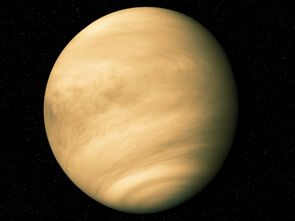
The surface of Venus is always hidden from view by thick cloud coverage. To the naked eye, it appears white and almost featureless.
"In many ways Venus is the hell planet...However, viewed in a different way, the problem with Venus is merely that the ground level is too far below the one atmosphere level. At cloud-top level, Venus is the paradise planet."
-Geoffrey A. Landis
Venus is the second planet from the Sun and the closest to Earth. It is very similar to Earth in size and mass, but due to a number of significant differences the conditions on Venus are some of the most extreme in the solar system.
Venus has a thick atmosphere composed of mainly carbon dioxide, which has led to a runaway greenhouse effect. The result is surface temperatures over 450 C, hot enough to melt lead, and atmospheric pressures ninety times that of Earth at sea level. Clouds of sulfuric acid are also present in large quantities, pushed by winds of up to 100 m/s in the higher levels of the atmosphere. In addition, Venus rotates extremely slowly and in the opposite direction of the other planets, resulting in a solar day lasting close to 117 Earth days. All of these present significant obstacles to colonization.
Proposals
Floating Habitats
The hellish surface environment of Venus makes even robotic exploration extremely difficult, and living directly on the surface would be nearly impossible. However, around 50 km above the surface the atmospheric pressure is approximately 1 atm, and temperatures in this band are a very reasonable 20 C to 37 C. An aerostat habitat or 'floating city' at this altitude would find possibly the most Earth-like environment in the solar system outside of our own planet.

NASA High Venus Operational Concept
Due to the density of the Venusian atmosphere, oxygen functions as a lifting gas and a structure filled with breathable air would float high in the clouds without additional volumes of lightweight gas. There would be no need for pressure suits or extensive heat shielding outside, and any gas leaks would not result in explosive decompression but rather slow diffusion. If untethered and allowed to move with the air, the high speed winds would push the habitat around the planet every four days, producing a day/ night cycle much closer to Earth and removing structural requirements for resisting the high winds.
Plentiful carbon dioxide could be used for plant photosynthesis, which would produce oxygen and food. Water vapor is present at around 20 ppm, as well as large quantities of sulfuric acid that could potentially be used to produce water. Solar energy is accessible even through the cloud cover, and the thick atmosphere above would provide radiation protection even given Venus' weak magnetosphere.
Terraforming of Venus
- Main article: Terraforming of Venus
Venus has been the subject of a number of terraforming proposals. The proposals seek to remove or convert the dense carbon dioxide atmosphere, reduce Venus's 500 °C (770 K) surface temperature, and establish a day/night light cycle closer to that of Earth's.
Most proposals involve deployment of a solar shade and/or a system of orbital mirrors, for the purpose of reducing insolation and providing light to the dark side of Venus. Another common thread in most proposals involves some introduction of large quantities hydrogen or water. Proposals also involve either freezing most of Venus's atmospheric CO2, or converting it to carbonates, urea or other forms.
| This page uses Creative Commons Licensed content from Wikipedia (view authors). | 
|